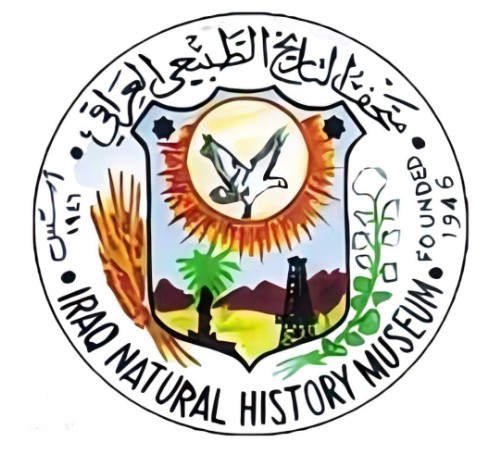FACIES ANALYSIS AND NEW DISCOVERY OF A MASTODONT FROM INJANA FORMATION (LATE MIOCENE) NEAR THARTHAR LAKE- MIDDLE OF IRAQ
DOI:
https://doi.org/10.26842/binhm.7.2018.15.1.0031Keywords:
Bone fossils, Facies analysis, Injana Formation, Iraq, Proboscidea, MastodontAbstract
The study area comprises Injana Formation (Late Miocene), exposed on the hills nearby of Tharthar Lake and about 120 km north of Baghdad city. This study depends on sedimentologic and facies analysis to recognize paleoenvironment and recognize the kinds of vertebrate bone fossils during Late Miocene. Sedimentologic and facies analysis showed many sedimentary facies: facies (Se) of scoured erosional surface, facies of (Sp) cross- bedded sandstones, facies (Fs) of fine sandstone facies, facies of (Fc) claystone, and facies of (C) calcareous clay. Facies analysis referred to the sub environments which are: point bar, over bank and floodplain in addition to fining upward cycles of deposition, which refers to meandering fluvial depositional environment.
Large vertebrate bone fossils were collected from the study area; the studied bone fossils probably are related to Proboscidea, Mastodont of Hemrin, which is named (Hemrin Mastodont). The current study considered the studied bone fossil as a new discovery of Proboscidea, Mastodont, which can be named (Tharthar Mastodont) after the name of the collection site of Tharthar Lake, from Injana Formation (Late Miocene), middle of Iraq. It was living near meandering fluvial environment which provided also plant diversity for herbivores.
Downloads
References
Al-Banna, N. Y. M. 1982. Sedimentological study of the Upper. Fars Formation in selected areas- Northern Iraq. M. Sc. Thesis. Mosul University, 177 pp.
Al-Mubark, M. and Youkhana, R. 1976. Report on the regional geological mapping of Al-Fatha- Mosul area. GEOSURV, internal report no. 753.
Al-Naqib, K. M. 1959. Geology of southern area of Kirkuk Liwa. Technical Publication, International Petroleum Company, 50 pp.
Al-Rawi, Y. T., Al-Sayyab, A. S., Jassim, J. M., Tamar- Agha, M. Y., Al- Sammarai, A. L., Karim, S. A., Basi, M. A., Dhiab, S. H., Faris, F. M. and Anwar, J. F. 1993. New names for some of the Middile Miocene- Pliocene Formations of Iraq (Fatha, Injana, Mukdadiya and Bai Hassan Formations), Iraqi Geological Journal, 25(1): 1-17.
Al-Sammarai, K. I. 1978. Petrology of the Upper Fars Sandstones and the origin of their cement. M. Sc. Thesis, University of Baghdad, 141 pp.
Al-Zubaidi, A. A. 2004. Mineralogical and geochemical study of rocks of Injana Formation from selected area, Central Iraq, and assessment of utilization for ceramic industries. Ph. D. Thesis. Department of Geology, University of Baghdad, 140 pp. (in Arabic).
Al-Zubaidi, A. A. and Jan, S. K. 2015. Vertebrate fossils in Fatha, Injana and Mukdadiya Formations in Iraq. Iraqi Journal of Science, 56(3A): 1983-1988.
Allen, J. R. L. 1964. Studies in fluviatile sedimentation of six cyclothems from the Lower Old Red Sandstone, Anglo- Welsh Basin. Sedimentology, 3:163- 138.
Basi, M. A. 1973. Geology of Injana area, Hemrin south. Unpub. M. Sc. Thesis, University of Baghdad, 141 pp.
Basi, M. A. 2007. Subsurface sedimentological study of Injana Formation (Late Miocene) in the area extended from Baiji to Sammarra cities. Central Iraq. Iraqi Bulletin of Geology and Mining, 3 (2) :43- 51.
Bellen, R. C. V., Dunnington, H. V., Wetzel, R. and Morton, D. M. I. 1959. Lexique Stratigraphique International. 03 10Asie, Iraq, 333pp.
Bernor, R. L., Solounias, N., Swisher III, C. C. and Van Couvering, J. A. 1996. The correlation of three classical “Pikermian” mammal faunas- Maragheh, Samos and Pikermi-with the European MN unit system. In: The Evolution of Western Eurasian Neogene Mammal Faunas, Bernor, R. L., Fahlbusch, V. and Mittmann, H. W.(eds.). Columbia University Press, New York, pp137-156.
Bernor, R. L., Fortelius, M. and Rook, L. 2001. Evolutionary biogeography and paleoecology of the Oreopithecus bambolii Faunal Zone (late Miocene,Tusco-Sardinian Province). Bolletino della Società Paleontologica Italiana, 40(2): 139-148.
Buday, T. 1980. The regional geology of Iraq: stratigraphy and paleogeography. In: Geosurvey of Iraq, Kassab, I. I. M. and Jassim , S. Z. (eds.)., Baghdad, 445 pp.
Gohlich, U. 1999. The Miocene land mammals of Europe. In: Gertrud E. Rössner and Kurt Hessig (eds.), Institute fur Palaonutologie and Historische Geologie, Munchen, Germany, 515pp.
Haynes, G. 1991. Mammuth, mastodonts. and elephants: Biology, behavior, and the fossils record. Cambridge University Press, 397pp.
Jassim, S. Z., Karim, S. A., Basi, M. A., Al- Mubarak, M. and Munir, J. 1984. Final report on the regional geological survey of Iraq, Vol. 3, Stratigraphy. GEOSURV, internal report number 498.
Konidaris, G. E. and Koufos, G. D. 2013. Late Miocene Proboscidea (Mammalia) from Macedonia and Samos Island, Greece: Preliminary Results, 87(1): 121–140.
Kukal, Z. and Saadallah, A. A. 1970. Paleocurrent in Mesopotamian Geosyncline. Sander Drukkans der Geologischen Runschan Band, 59: 666- 685.
Lister, A. M. and Sher, A. V. 2001. The origin and evolution of the woolly mammoth. Science, 294: 1094- 1097.
Miall, A. D. 1977. Fluvial sedimentology. Lecture series, Canadian Society of Petrolium Geologist, Calgary, 37pp.
Miall, A. D. 1978. Fluvial sedimentology. Canadian Society Petroleum Geologists, Memoir, 5: 859 pp.
Miall, A. D. 1988. Reservoir heterogeneities in fluvial sandstones: Lession from outcrop studies. American Association of Petroleum Geologist Bulletin,72(6) : 682- 697.
Moore, R. C. 1949. Meaning of facies. In: Longwell, C. (eds.), Sedimentary facies in geological history. Geol. Soc. Amer. Memior 39: 1- 34. In: A. D. Miall, 2016. Stratigraphy: A Modern Synthesis, A comprehensive review of modern stratigraphic methods. Springer, 454 pp.
NogÚes- Bravo, D., Rodriguez, J., Hortal, J., Batra, P. and Araujo, M. B. 2008. Climate change, humans, and the extinction of woolly mammoth. Plos Biology, 6 (4): e 79.
Opluštil, S., Martínek, K. and Tasáryová, Z., 2005. Facies and architectural analysis of fluvial deposits of the Nýřany Member and the Týne Formation (Westphalian D– Barruelian) in the Kladno- Rakovník and Pilsen basins. Bulletin of Geosciences, 80(1): 45–66.
Piveteau, J. 1935. Mammiferes du Pontien de Iraq. Bulletin of Geological Society of France, 5(5): 468- 470.
Selley, R. C. 1977. An Introduction to Sedimentology. Academic Press London, New York, 408 pp.
Teichert, C. 1958. Concept of facies. American Association of Petroleum Geologist Bulletin, 42: 2718- 2744.
Thomas, H., Behnam, H. A. M. and Ligabue, G. 1981. New discoveries of vertebrate fossils in the "Bakhtiari Formation", Injana area, Hemrin South, Iraq. Journal of Geological Society of Iraq, 14 (1): 43-53.
Valli, A. M. F.2005. Taphonomy of the Late Miocene Mammals locality of Akkasdagi, Turkey. Geodiversitas, 27 (4):793-80.











